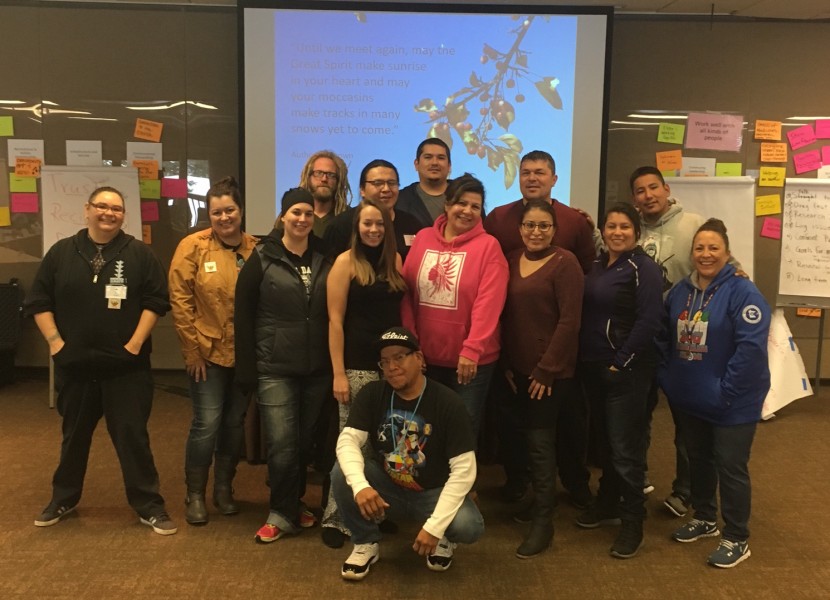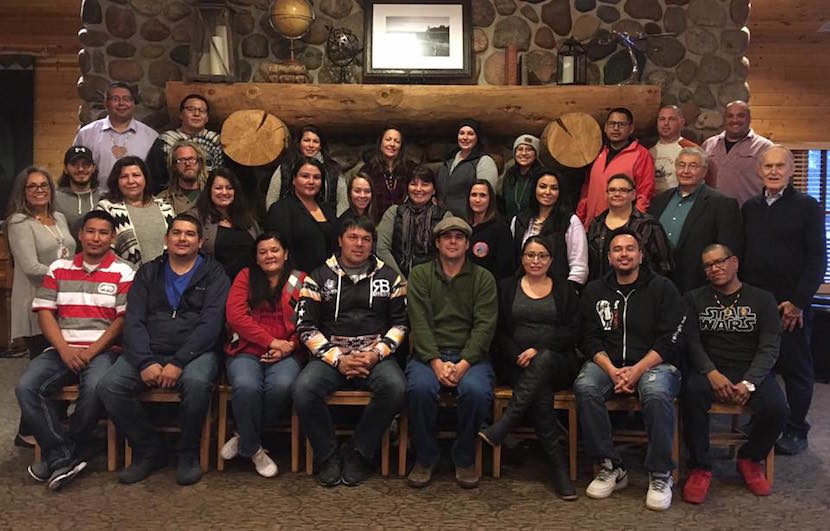
In mid-October, as the first of this winter’s snow started to accumulate, 14 Mille Lacs community members made their way to Sugar Lake Lodge just south of Grand Rapids to participate in the Blandin Reservation Community Leadership Program (BRCLP). Most participants arrived on Sunday night to settle into the comfortable townhomes the resort offers and complete their first assignment for the training, which they found waiting for them upon check in. Before any training sessions began, each person was asked to take a 144-question test and evaluate themselves based on the Myers-Briggs Type Indicator system. It set some people up for surprise when they found that they tested quite differently from the way they saw themselves. This opened the door to the theme of discovery throughout the training process.
Mille Lacs Band and community members Craig Beaulieu, Li Boyd, Govinda Budrow, Gilda Burr, Colin Cash, Maria Costel- lo, Shelly Diaz, Jeremiah Houser, Shena Matrious, Amy Opager, Dean Reynolds, Arlyn Sam, Kaitlin Thompson, and Virgil Wind represented this year’s cohort, which also included participants from Lower Sioux, Upper Sioux, Shakopee Mdewakanton and Prairie Island Indian communities. Together this group of twenty-six community members became the most recent of over 600 reservation community leaders that the Blandin Foundation has provided training to since 2001. Distinguished graduates include our own Melanie Benjamin and many other tribal officials from all eleven Minnesota reservation communities.
Even with the Myers-Briggs Type Indicator (MBTI) booklets in hand, many participants weren’t sure what to expect the first morning of training. They were quickly introduced to one of the program’s fine trainers, Roxanne DeLille, whose boundless energy and charisma kept the cohort going all week long, despite the in- tense and sometimes draining nature of the discussion. Roxanne started by asking the group a deceptively simple question: What is your vision for a healthy community?
What makes the BRCLP unique is that it’s tailored to discussing the leadership needs of reservation communities and the challenges they face due to historical trauma, ongoing systematic oppression and the things that make Indigenous people culturally different from both each other as individuals and mainstream culture in the United States. Students were shown very quickly that there is a fundamental difference between the way Indigenous people view, prioritize and take action in the world when compared to the dominant non-Native paradigm. Where western culture is focused on financial capital and individual wealth, Indigenous cultures concern themselves with personal and community wellness, which encompasses both physical and spiritual well being.
“We’re not asking you to become something else,” Roxanne said early on.
So there were no rote exercises about how work flows in a hierarchy or what one might expect from a typical leadership or management training. Instead, there was exploration of the gifts each person is granted by the creator and ways to incorporate skills that have been acquired along the way. It was important to the trainers to help participants understand that communities have power together, so all must learn to work together to be effective within the community.
“My way or the highway does not work in community leadership!” Roxanne recited many times.
This means listening to one another, building networks of social capital and also learning to look at the positive things that are available in our communities. Recognizing one another may have been the most important facet of all three of these things. Whether it had to do with just listening to each other’s backgrounds and stories or learning about the projects people are most passionate about, creating connections is what the training all boiled down to.
According to Dean Reynolds, “The bond and trust we made with each other was the real lesson for us to learn. If we could do that with everyone in the community it would greatly strengthen our rez.”
During the quick ten-minute breaks between sessions, many members of the group even went sledding down a hill outside the conference center, encouraging each other to have some fun and offering a hand whenever anyone fell down. It all circled back to one of the initial messages that Roxanne DeLille told the group in the beginning: You’re not alone.
Gilda Burr said, “Blandin Leadership has offered me a discovery of my own self-worth. It has empowered me to find a connection with others by understanding how I can play a part in resolving social issues that I deem important within my own community.” Planning for potential community projects has already begun now that everyone has settled in back at home with their new networks of support, friendship, and common goals.
All of the participants expressed gratitude to the program facilitators and especially the trainers. This includes Vic Klimoski, who can be considered Roxanne DeLille’s somewhat more dry-humored counterpart. The training was also facilitated by Rick Smith, Director of the American Indian Learning Resource Center at the University of Minnesota Duluth, and Bill Blackwell Jr., Executive Director of the American Indian Resource Center at Bemidji State University. Participants are also grateful to the staff of Sugar Lake Lodge who kept things comfortable, tasty and working during their stay.
The BRCLP doesn’t end at Sugar Lake Lodge. A segment of on-going training will occur in February in St. Cloud along with a commencement ceremony for the program graduates. The Blandin Foundation provides all these trainings free of charge to the participants, through grants and the endowment created by Charles K. Blandin when he first decided he wanted to leave a legacy for Minnesota’s rural communities in 1941. His efforts are well appreciated.
Jeremiah Houser, a long-time employee of the Mille Lacs Band DNR, a family man, a teacher of medicines, a provider of ceremonial materials, and an advocate for sustainable and self-sufficient living, said, “I came to Blandin because someone believed in me and told me to apply. I think the real goal and message from Blandin was us. It was a spiritual teaching to us to see our value within ourselves and to not hide it. I think that the real meaning behind the Blandin program is a message of healing, hope, and confidence to all that are privileged to attend.”
